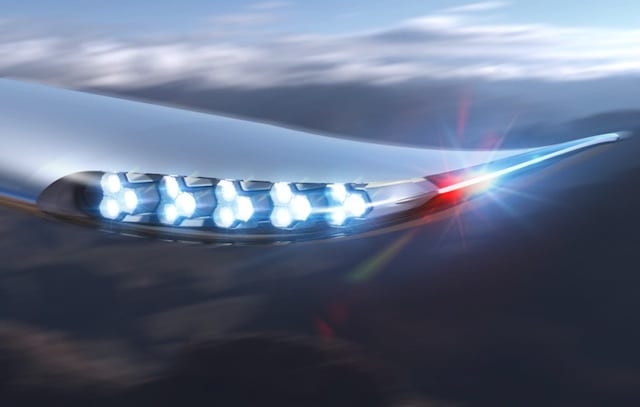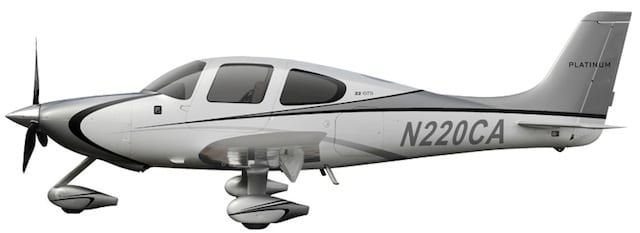DULUTH, Minn. — Cirrus Aircraft has introduced the company’s model year 2014 SR-Series airplane lineup.
“The most immediately recognizable new feature for 2014 is that we have brought luxury automobile LED lighting technology to the airplane, a first in our segment. Cirrus Integrated LED Technology increases functional performance while enhancing aesthetic appeal for Cirrus customers,” states Todd Simmons, executive vice president, sales, marketing & customer support. “Of course the new level of clarity and brightness is remarkable, but you just can’t help but be taken by how cool our new LED package looks!”
 The multi-function LED lighting system, called Cirrus Integrated LED Technology, is integrated into the wing and provides a range of functions including:
The multi-function LED lighting system, called Cirrus Integrated LED Technology, is integrated into the wing and provides a range of functions including:
- Ground illumination for night pre-flight walk-arounds
- Tail surface illumination
- Anti-Collision lights
- Navigational position lights
- Landing light assistance
- ‘Halo’ accent lighting
Additionally, the flush-mount installation not only reduces drag, but also adds LED reliability and brightness, according to company officials. These lights can be activated using a key fob or with switches from inside the cockpit.
Also new for 2014 are re-imagined Carbon and Platinum Appearance packages.
Inspired by the style of the most legendary sports cars, the Carbon Appearance package utilizes a new palette of accent colors. Interior details such as jet black vents, carbon fiber instrument panel lobes and two-tone leather bolster seats complete the new look.
Fluid lines and a collection of earthy exterior colors highlight the new 2014 Platinum Appearance premium upgrade, according to Cirrus officials. Nickel vents and solid color leather bolster seats provide the finishing touches, officials note.
 The 2014 Cirrus aircraft line-up features a new high-performance Beringer brake system that reduces weight and enhances performance and safety. Called Beringer Aero design, these brakes provide the same stopping power but with less mass and is achieved with a smaller rotor that performs at a cooler overall operating temperature. They also allow the use of tubeless tires to provide a higher level of reliability when compared to traditional tube tires, reducing the risk of leaks and failures, company officials said.
The 2014 Cirrus aircraft line-up features a new high-performance Beringer brake system that reduces weight and enhances performance and safety. Called Beringer Aero design, these brakes provide the same stopping power but with less mass and is achieved with a smaller rotor that performs at a cooler overall operating temperature. They also allow the use of tubeless tires to provide a higher level of reliability when compared to traditional tube tires, reducing the risk of leaks and failures, company officials said.
Generation 5 is the name given to the airframe change required to achieve the 200-pound increase in useful load first introduced in 2013. The entire aircraft design was analyzed from spinner-to-tail and many parts and systems reengineered and redesigned to accommodate the increased airframe load, aerodynamic improvements, improved flight performance and the Cirrus Airframe Parachute System (CAPS). Testing, including a new series of parachute test drops, was conducted for validation.
Other airframe upgrades included strengthening the carbon fiber, single-part wing spar, the landing gear and a new flap system, allowing extension to the first position at 150 knots.
Model Year 2014 SR-Series aircraft are available for pre-order today with next deliveries available in the first quarter of 2014.

To ManyDecadesGA:
It’s a Cirrus, not an A380. It strikes me that it makes you really unhappy that they don’t have the same capabilities, be it for current, existing systems, or yet-to-exist future systems.
Guess you shouldn’t buy one, then.
SB
I have absolutely no idea of what “ManyDecades” is talking about. However, all of this new Cirrus stuff is impressive and undoubtedly make the aircraft more enjoyable. And even more effective as far as the brakes and wheels go. Question is at what price? Cirrus just keeps adding and improving and moving the price bar ever higher. Maybe that’s what their market demands but at some point they are just going to price themselves right out of the market. Then they will probably come up with a stripped down “bargain” airplane or something similiar.
@unclear. I agree with your cost/price concern. However that issue typically plagues all of GA’s OEM new offerings.
Regarding the CNS issues, you better pay attention, because the eventual adverse consequence for you, me, and for all GA is enormous. GA will soon both be priced out of the future global airspace system, as well as be denied important future airspace access at any GA affordable cost, largely because most current GA “glass” CNS systems are poorly designed and horribly inefficient (as well as having poor human factors interfaces). The systems do not yet have serious RNP capability needed for efficient and low cost trajectory separation, while foolishly still depending on concepts like obsolete WAAS/LPV. They don’t even have decent path bounding VNAV yet. This leads to especially poor airspace use (e.g., unable to meet RNP based separation trajectories), which in turn leads to excessive, inefficient, and costly aircraft-aircraft separation criteria, which drives up airspace use costs, to eventual GA unaffordable levels. Present typical GA GPS navigators squander critical busy airspace unnecessarily via still using unbounded RNAV, or worse yet, angular straight-in criteria such as the soon to be obsolete, and very inefficient LPV procedures. Whereas RNP based procedures can address 2D, 3D, and even 4D bounds, and extent, thus can alternately use vastly less airspace to safely separate more aircraft, better negotiate terrain and obstacles, as well as safely avoid conflicting nearby airport airspace, for entirely independent IFR/IMC, VFR/VMC, or in the future EFR operations. RNP, especially combined with data link and automated conflict probe and resolution can provide the basis for a vastly better INAS, at much lower relative cost, which is key to GA’s future long term survival.
ManyDecadesGa, not to be disrespectful but what are you talking about?? The bigger picture is that GA’s future hinges on companies like Cirrus. GA is benefitting from the innovation and market growth. Not to mention companies like Cirrus are committed to broadening the scope of safety -and not just for GA.
I see no negatives in the GA equation.
But can it do RNP .3 to RNP .1 SIAPS, SIDS, and STARS, with VNAV yet (the global ICAO standard for Navigation, as all new production jet transports will do)???
And does it still waste money on avionics using unnecessary and obsolete WAAS (with soon to be nearly 100 GNSS space vehicles out there to eventually be orbiting, for all the needed accuracy and integrity ever to be required) and using provisions for multi constellation sensing, with inertial filtering?
And is it still trying to do limiting straight-in angular LPV that just wastes GA’s valuable airspace in busy metro areas, fouling up GA airports, instead of the less expensive and much more efficient RNP based procedures?
And is Gen 5 prepared to incorporate a VDL Mode 2 or FANS COM Data Link, and the much better and more capable GLS, the eventual replacement for expensive and hard to maintain ILS facilities, that GA won’t be able to afford in the future, as fully allocated INAS costs are eventually pushed to be recovered from GA?
Now is the time to start incorporating these RNP, VNAV, Data Link and GLS advances, via a good low cost FMS with a good human interface, if this aircraft hopes to have a fleet life and safety record anywhere near that of a 1962 C172C, for which a local model has been doing a “poor man’s version” of RNP .1 for years now.
Even the Sport and amateur aircraft appear to now passing up FAR23 aircraft in important avionics capability.